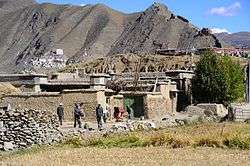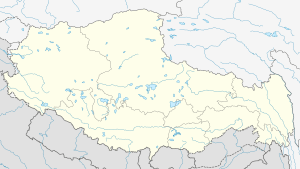Qonggyai County
| Qonggyai County • Chongye County | |
|---|---|
| County | |
 Near the Valley of the Kings | |
.png) Location of Qonggyai County (red) and Shannan City (yellow) within Tibet | |
 Qonggyai Location of the seat in Tibet | |
| Coordinates: 29°15′30″N 91°51′30″E / 29.25833°N 91.85833°E | |
| Country | People's Republic of China |
| Region | Tibet Autonomous Region |
| Prefecture-level city | Shannan |
| Area | |
| • Total | 1,030 km2 (400 sq mi) |
| Population (1999) | |
| • Total | 17,031 |
| Time zone | UTC+8 (China Standard) |
| Website | http://www.xzqjx.gov.cn |
| Administrative division code: 542225 | |
Qonggyai County or Chongye County, (Tibetan: འཕྱོངས་རྒྱས་རྫོང་, THL: Chonggyé dzong , simplified Chinese: 琼结县; traditional Chinese: 瓊結縣; pinyin: Qióngjié xiàn) is a county of Shannan in the Tibet Autonomous Region.
History
Qonggyai contains the Valley of the Kings, a series of graveyard tumuli, approximately 27 kilometres (17 mi) south of Tsetang, Tibet, near the town of Chongye or Qonggyai on Mure Mountain. The site possesses eight large mounds of earth resembling natural hills that are believed to contain eight to ten buried Tibetan kings.[1]
According to Tibetan tradition all the kings from Dri-gum onwards are buried at ‘Phyong-rgyas, but as the site now presents itself, there are just ten tumuli identifiable as the tombs of all the kings from Srong-brtsan-sgam-po to Khri-lde-srong-brtsan, including two princes.[2]
Other sources, however, have indicated that there are actually nine mounds rather than eight or ten.[3] The kings believed to be buried at the site include Songtsen Gampo (the founder of the Tibetan Empire), Mangsong Mangtsen, Tridu Songtsen, Gyangtsa Laban, Me Agtsom, Trisong Detsen, Muné Tsenpo and Ralpacan.[1][4]
Qonggyai Dzong was established in mid-14th century under Phagmodrupa rule. Under the Ganden Podrang, the county was part of Lhoka Governor's (Tibetan: སྤྱི་ཁྱབ་, Wylie: spyi khyab ) jurisdiction. Since 1960, Qonggyai county is part of Lhoka (Shannan) prefecture.
Geography and climate
Qonggyai County is located in the middle of the Brahmaputra River valley and covers an area of 1030 square km, with 2.8 million mu of arable land, an area of 1.3 million mu of grassland, with a forest area of 0.7 million mu.[5] The county had a total population of 20,000 people in 2003.
Qonggyai County is located in southern Tibet and is surrounded by mountains. It has an average elevation of about 3900 meters, with a maximum altitude of 6450 meters.[5] It is in a temperate semi-arid plateau monsoon climate zone, with an annual frost-free period of about 125,153 days.[5] The annual rainfall is 345 millimeters and natural disasters, mainly droughts, floods, hail and pests are common.[5] Mineral resources include mainly crystal stone, jade, chromium and iron. Antelope, black-necked crane, otter, swan, eagle and river deer are common.[5]
Economy
Qonggyai is dominated by agriculture, and is one of the grain based counties in Shannan.[5] Crops grown are mainly highland barley, winter wheat, spring wheat, peas, radish, potatoes and so on.[5] Livestock include yak, pianniu, cattle, sheep, goats, mainly. A forested area of 150 acres (0.61 km2) contains some apple, pear and peach orchards. Ethnic handicrafts forms most of the industrial sector and products include buckets, kettles, Tibetan cabinets, bowls, bracelets, necklaces, incense, butter lamps, etc.[5]
The capital, Qonggyai Town (Qonggyai, Chongye) contains an ancient castle, and covers 0.5 km2 (0.19 sq mi), with a population of nearly 500 people.[5] Commercial, financial, telecommunications, hospitals, schools and other public facilities are located in this small political, economic, and cultural center.
Towns and populated places
- Qonggyai Town (Qonggyai, Chongye)
- Qoi
References
- 1 2 Tibet:A Fascinating Look at the Roof of the World, Its People and Culture. Passport Books, Shangri-la Press, Chicago, USA. 1986. pp. 143–145.
- ↑ Snellgrove and Richardson (1968), pp. 51-52.
- ↑ "The Graveyard of Tibetan Kings". Travel China Guide. Retrieved September 8, 2009.
- ↑ Stein (1972), pp. 201-202.
- 1 2 3 4 5 6 7 8 9 琼结县 (in Chinese). Baidu Baike Encyclopedia. Retrieved February 26, 2010.
Coordinates: 29°15′30″N 91°51′30″E / 29.25833°N 91.85833°E
